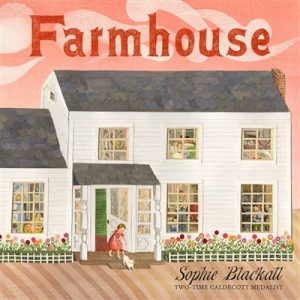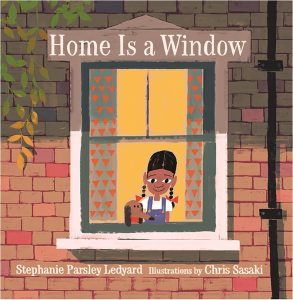by Charlene Klassen Endrizzi, Westminster College, PA, Bobbi Jentes Mason, Fresno Pacific University, CA, Karen Matis, Shenango Area School District, PA and Grace Klassen, Exeter School District, CA
“Our [nation] wasn’t originally built for everyone. Some took light-filled rooms with beautiful views. Others were consigned to basements. We’ve got to renovate so that there are good rooms for all — so that power is broadly shared.” (Danielle Allen, 2023 ).
This month Bobbi, Karen, Grace and I come together to examine the hope of home and affordable housing for all families. Through our first feature blog, we explore picturebooks offering “light-filled rooms with beautiful views” through Home is a Window and Farmhouse. Next week we assume a much less comfortable “basement” stance by examining the living spaces of under-resourced families through The Blue House, Sanctuary, The Notebook Keeper and I See You. Each situation helps us broaden our notion of home. Each text can inspire dialogic conversations with students to help broaden their lens on others who might find themselves in uncertain home settings.
When you consider the students you learn with, how do you imagine they perceive home? Certainty or uncertainty? Bobbi offers these essential questions to frame our book exploration: What makes a home? Is it a place? Is it people? or a feeling? What makes a house a home?
Home is a vital window for teachers to examine throughout the school year as they aim to understand the complexities facing their students outside of school. Through Home Is a Window, Stephanie Parsley Ledyard with illustrator Chris Saski invite readers to join a young girl with her family as they discover a new view on life through a move from an urban brownstone to a suburban home. The child’s first home window offers the feeling of familiarity, certainty and safety. Comfort is evoked through gentle greetings like “Hello, sweet pea.” Feelings shift as the biracial family of four manage uncertainty by moving to a home offering new windows and potential. Stephanie and Chris evoke home in their exploration of both the inhabitants and the feelings with vivid lines such as: “Home is all that you miss.”
The author reveals an array of possibilities she hopes readers explore in her text this way. “I kept thinking of the meaning of home. What makes a home? What are the most basic elements of home in different cultures? Is a home a place, or is home the people within? Can home be a feeling?” Her questions are useful to spark classroom conversations to launch a study of home life from various perspectives.
 Sophie Blackall, recent Caldecott medalist, takes readers on an evocative journey through an aging farmhouse which is an actual deteriorating structure near her Milkwood retreat center in the western Catskills of New York. Before reading, you might want to virtually visit this inspirational space, and see for yourself a declining parlor organ, remnants of hand-made dresses, rain-soaked wallpaper and more. Sophie brings the dilapidated space to life by imagining the goings-on of a family with twelve children and slowly revealing how she discovered this home, her inspiration for creating Farmhouse.
Sophie Blackall, recent Caldecott medalist, takes readers on an evocative journey through an aging farmhouse which is an actual deteriorating structure near her Milkwood retreat center in the western Catskills of New York. Before reading, you might want to virtually visit this inspirational space, and see for yourself a declining parlor organ, remnants of hand-made dresses, rain-soaked wallpaper and more. Sophie brings the dilapidated space to life by imagining the goings-on of a family with twelve children and slowly revealing how she discovered this home, her inspiration for creating Farmhouse.
This picturesque family story centers equally on home as a comfortable space in time as well as the inhabitants. Take time to note Sophie’s attention to detail as seen in the delicate wallpaper and bedroom walls covered with ribbons, photos and paintings. For Grace and me, this idyllic look at farm life reminds us of our maternal grandparents’ dairy farm on Townline Road in Clearbrook, British Columbia. Sophie’s intricate illustrations, including a second floor space which holds the children’s bedrooms to the first floor parlor and kitchen space with a prominent stove for heating and cooking, remind us of our much-anticipated getaways to Henry and Martha Suderman’s farm.
In hindsight as we continue to pour over these texts, we recognize our privileged status. This second narrative centered on the safety and certainty of home encourages us to pause and consider many families, including our immigrant grandparents, who were afforded home loans to purchase a house and even a farm, thereby building home equity for themselves and their heirs.
We pause to consider the struggle of home ownership for many people of color, facing housing segregation through the Federal Housing Administration’s and G.I. Bill’s policies. A careful study of these national discriminatory practices reveals the tragedy facing residents of predominantly Black neighborhoods. They hopelessly encountered redlining housing policies in the 1930s — 1960s, thus halting Black social mobility. Teachers like us, from working class families who owned homes, found a financial path forward by building home equity through home ownership often before the age of 30. In order to imagine the notion of home alongside diverse student populations and their families, we need to contemplate the struggle of those in public housing or those who faced redlining policies that denied them the opportunity to obtain home loans or mortgages. Both Zinn Education and Learning for Justice enable us to broaden our awareness of this shocking injustice.
In our next post, Bobbi, Karen, Grace and I return to explore four contrasting books offering a more uncomfortable look, a “basement” view as inhabitants face uncertainty in their housing predicaments. In closing, we hope you share books such as these first books offering “light filled rooms with beautiful views” juxtaposed to diverse perspectives on home. In thoughtful conversations with our diverse students, we can use essential questions like “What is home for you?” as we seek to broaden our lens and awareness regarding the uncertainty and power of home spaces.
WOW Currents is a space to talk about forward-thinking trends in global children’s and adolescent literature and how we use that literature with students. “Currents” is a play on words for trends and timeliness and the way we talk about social media. We encourage you to participate by leaving comments and sharing this post with your peers. To view our complete offerings of WOW Currents, please visit its archival stream.

